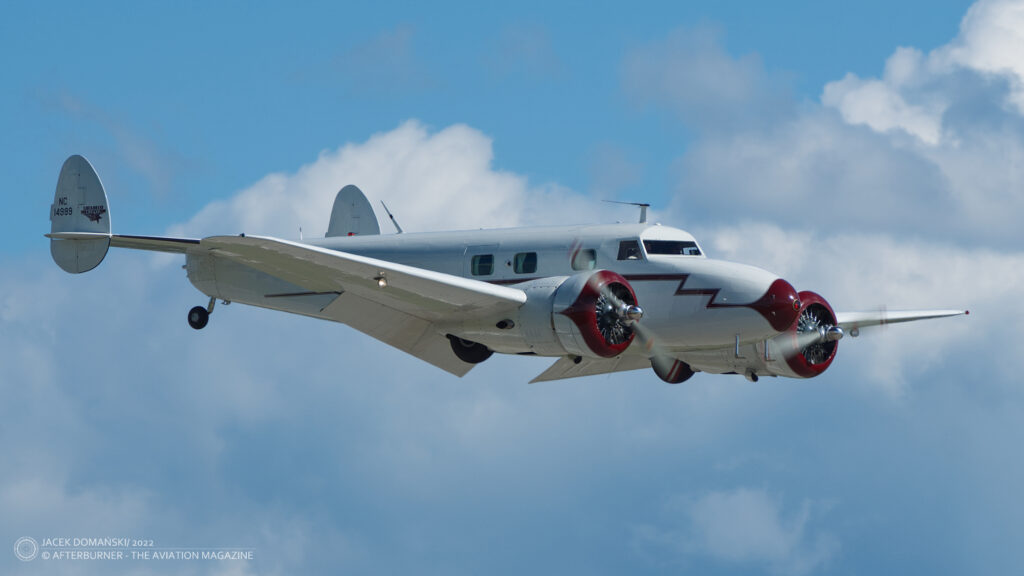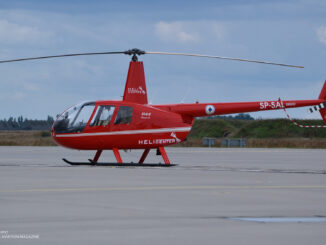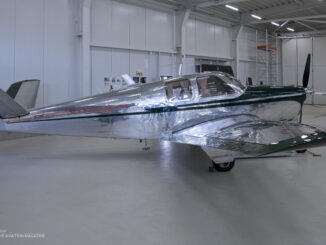 Lockheed Model 12 Electra Junior (c/n 1252, NC14999), flying display at the 30th edition of Aviation Fair air show, Pardubice, May 2022.
Lockheed Model 12 Electra Junior (c/n 1252, NC14999), flying display at the 30th edition of Aviation Fair air show, Pardubice, May 2022.
The Lockheed Model 12 was developed as a smaller derivative of Model 10, a twin-engine airliner for ten passengers that was brought to the market in 1935.
Works on the aircraft have begun in the mid-1930s and initially the new aeroplane was intended as corporate aeroplane, as well as feeder airliner. The latter was the answer to a competition announced by the US Bureau of Air Commerce that declared there is a demand for such an aircraft among the American airline operators.
Basically, the Model 12 was just a scaled down Model 10 Electra. It could carry up to six passengers and the crew of two, had the same all-metal, monoplane structure as the Model 10, similar shape including twin tail fins and rudders, as well as used the same Pratt & Whitney R-985 Wasp Junior radial engines.
On 27th June 1936, just a few days before the deadline of 30th June stated in the competition rules, the Electra Junior performed its maiden flight. An interesting fact is that the first flight of the Model 12 was performed at midday, exactly at 12:12 hours.
The aforementioned competition was won by the Electra Junior by default, as none of the two other competing aircraft – Beechcraft Model 18 and Barkley-Grow T8P-1 – were not ready within the given deadline. Nevertheless, winning the contest was soon proved useless as the government expectations diverged from reality. The truth was, almost no airline expressed its demand for such type of aeroplane nor ordered the Model 12.
Therefore, Lockheed began with advertising the Electra Junior as what we would call today a ´business aircraft´, aiming for company executives, especially from oil and steel sectors, as well as government officials. Shortly after, the Model 12 became a popular business utility aircraft, faster and more cost-effective than the Model 10.
The overall better performance of the Electra Junior was a result of using the same engines as in the Model 10, with smaller size of the aircraft and its lower weight. Good flight characteristics of the ´Baby Electra´ – as the Model 12 was commonly nicknamed – was confirmed during the 1937 edition of Bendix Trophy Race. The Electra 12A equipped with additional fuel tanks and flown by American aviator Milo Burcham completed the entire race route of 3,288 km without any stops and at an average speed of 296 kph. Burcham and his Electra took the fifth place and were beaten only by much smaller and faster aircraft of different category, such as Seversky P-35 fighter.
The Lockheed company manufactured the Model 12 until 1941 when, with the US fully committed to the World War II, it switched to produce military aircraft, such as P-38 Lightning or Hudson. Up to that time, a total number of 130 Electra Junior aeroplanes was built.
The beginning of the Second World War meant also the Model 12 was introduced to military service. The Electra Junior was initially used as a transport aircraft by the United States Army Air Corps (designated C-40) and the United Navy (JO or R3O-2). Next, it was used by the Royal Air Force, the Royal Canadian Air Force, the Brazilian Air Force, the Argentine Army, the Indonesian Air Force and the South African Air Force. The Model 12 was used for the VIP and troop transport, as well as reconnaissance and patrol duties.
However, it was the Royal Netherlands East Indies Army Air Force that used the Model 12 in the most extraordinary role. The Netherlands armed forces acquired a total number of thirty-six Junior Electras with sixteen of them then re-built into Model 212 – an aircraft intended for bomb crew training, equipped with bomb racks and machine gun turrets.
Last but not least, two very special Junior Electra aircraft must be mentioned. Officially owned by British Airways Ltd., the aeroplanes were modified for covert military reconnaissance flights. That unusual adaptation was made by the famous Australian aviator, inventor and photography pioneer Frederick Sidney Cotton, acting on behalf of MI-6 intelligence service.
Cotton equipped the Model 12 with four cameras hidden behind sliding panels and controlled with the secret button under the pilot´s seat. At the eve of the World War II, Cotton performed a series of reconnaissance flights over Germany, the Middle East and North Africa. What´s more, he also met with some highest Nazi authorities and even managed to operate the cameras while flying over Germany with Albert Kesselring, one of the Luftwaffe commanders. Cotton´s Electra was reportedly the last aircraft that left Berlin before the outbreak of the war.
With a kind of ironic twist of fate, when Lockheed concluded the production of the Model 12, its place on the market was taken by another aircraft and it was exactly the one that failed to meet the deadline of the 1937 government competition – Beechcraft Model 18 ´Twin Beech´. That aeroplane was used worldwide as executive, utility, passenger and cargo aircraft by both civilian and military operators. Until 1970, when its production was ceased, there were more than 9,000 of the Beechcraft Model 18 aircraft built.



